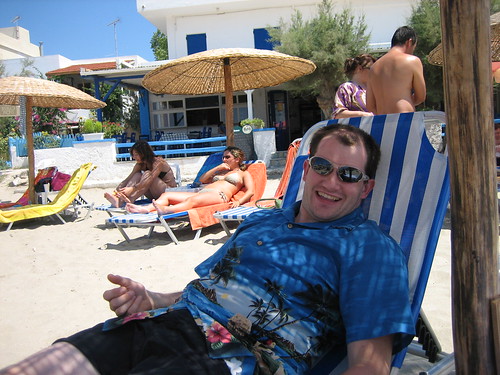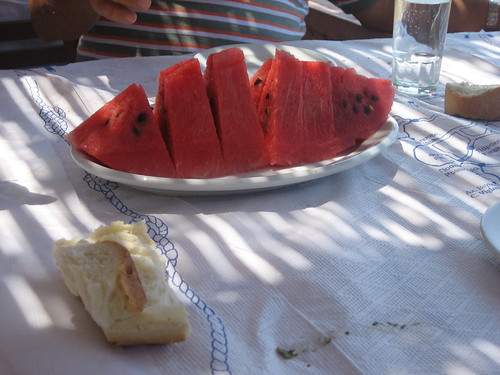A vacation, of course, being that thing from which I am just returned. Well, sorta. I have a few more days off to get over soul lag. Photos will probably pop up in the Flickr stream soon. For now, some notes.
I think three weeks (more or less) was exactly the right amount of time to be on vacation. The basic problem with going from Vancouver to a small cycladic island is that it takes, more or less, 3 days to get there, and 3 days to get back. You can fudge this number a few ways, but there are essentially no direct flights that go YVR to ATH, and the ferry trip from Piraeus (the port of Athens) and Syros takes four hours by the slow ferry, maybe half that by the fast ferry, and I’ve never investigated the option of taking the 30-minutes-or-so flight, which is not daily). With one air connection and one boat connection to cover, your 18-odd hours of travel time will probably feature some layovers.
Syros itself was lovely. I don’t know how much of this will translate for others, though: The Lovely One and I had the incredible advantage of staying at her parents’ recently-built house, which is described by the locals as way out of town. In fact, it is about 15 minutes from the centre of the downtown core. The house is very close to being the most distant dwelling on the island from the main city, and is pretty rural. Our neighbours were the house across the street and 200 metres from the road, the other house 100 metres down the road, and the goats in the field below us. there were maybe two or three more dwellings within sight of the house. That was it. In the right place on our balcony, we could see the Milky Way at night.
The only catch was the Harrowing Road of Death between the house and the town of Ermoupolis, the big town. It was a near-parody of a mountain road: switchbacks, narrow, blind corners, extreme examples of contour-following on hillsides, roadway literally carved from the slope in some cases, with shoulders that alternated between the vertical cliff face and the vertical cliff drop. A few guardrails were thrown in at apparently-randomly-chosen corners, though I couldn’t figure out what distinguished the selected corners from the entirely scary places that didn’t have guardrails.
A Greek island in August is a near thing to paradise. We got lucky in this trip with excellent weather, just a tad milder than the seasonal norms, and mitigated always by the still-very-real local practice of siesta. How real? Most of the things you will want to see or do are going to be closed between mid-day and 1900h. Just go to the beach, or better yet, take advantage of the time to work on a nap, since it’s hot, and you’re going to be up until 0200h, since you started dinner at 2300h, and it takes two hours to eat.
The nearest thing to paradise would probably be the same island in spring or fall. The locals claim the water (there’s maybe 15 major beaches, and as many again minor or hard-to-reach ones) is un-swimmable for about two weeks around New Years. I suspect anyone who has taken a dip in the ocean near Vancouver wouldn’t blink twice at Mediterranean swimming at any time of the year.
We took two day-trips to other islands while we were there. The first was to Paros, where we overpaid heroically to rent the last scooter on the island (mid-August, revolving around the national holiday for the Feast of the Assumption on August 15th, is the high season for Greeks to go on vacation, and they go to the cycladic islands), and had an okay time. This was my second trip to Paros (we visited on our honeymoon seven years ago), and both of us felt we had pretty much done the island. The highlights for new visitors probably come down to seeing Lefkes, and maybe going to our favourite pottery shop, Studio Yria. Two notes on studio Yria: the Lefkes shop is now closed, and be sure that if you ask the way, you’re being directed to the pottery studio near Kostos, not the bed and breakfast on the other side of the island (a mistake that led us on a pleasant diversion in 2000).
Naxos was different. Bigger, greener, more trees, new to both of us, more stuff of archaeological and historic interest (everything from the Naxos portal to an endless array of 6th-to-10th c. Byzantine churches, most still in use today). We liked it, and will probably return the next time.
On both our island trips and at “home” on Syros, we were complete suckers for the brown signs that in Greece direct you to a historic or archaeological site. the guidance is often vague (and seems no better in Greek than English; most road signs were bilingual), and we repeatedly found ourselves following the brown signs then then not finding our destination. On a few occassions, it became apparent that the brown signs led to a location which was very long hike from the last road. Greek footpaths are routinely little more than goat paths. None of this mattered, since the journeys really were as interesting as the destinations: at one point we followed the signs to the end of the road, walked through a semi-abandoned rural village, and never saw our theoretical goal. But on the way back I found an untended apricot tree, picked as many partly-dried apricots as I could, and ate about six or seven before TLO’s wise counsel intervened. Good times!
We rented a small car (Kia Picanto with a 1000cc motor) on Syros, and scooters on our island trips. TLO and I continue to debate the merits of the car. On one hand, it was a very nice car, peppy, air-conditioned, and with plenty of room for a bag or two. On the other hand, parking was so bad in Ermopoulis that by the end of our stay we found ourselves avoiding trips downtown, which was a shame. Parking would not have been an issue for a scooter, and we continue to debate whether the Harrowing Road of Death would have been less scary on the scooter (because I could drive further from the edge of the cliff) or more scary (because, well, it’s a scooter). On the gripping hand, I accepted the gift of a bicycle from one family friend, and returning to the house on a scooter might have been rather interesting.
Amusingly, the cars (including rentals) in Greece are almost universally manuals, while the two scooters we rented both featured CVT automatics (as is typical). Greek driving was characterized by a bit of loonyness, surprisingly little horn-honking, and an awareness of the very tight margins involved. You have to be aware that your car and the oncoming car will frequently just fit through the roadway, or maybe require taking turns through the narrow bit, and if there’s a foot on either side of your car, it may soon be filled by a scooter or motorcycle. Our road travel was largely uneventful.
Ferry travel in Greece ranges from amusing to annoying. I’d suggest that if you take the Blue Star Ithaki (the main near-Cyclades car ferry from Piraeus), especially during the high season, that you seriously consider the few extra Euros for reserved seats, which are comfy and will save you the stress of finding what you can. TLO and I had relatively little trouble sitting on either leg of our trip to Syros, but it was a near thing. The boats we took to Naxos and Paros were a mixed bag: the Flyingcat 3 to Paros was a hot-rod turbine-powered catamaran, capable of 60 knots, making trips half as long as on the slow ferries. Internally, it was all reserved seats but not very inspiring. I loved the bilingual house magazine, Pelagos, for its surreal musician interviews.
Our other two boats were Nel Lines’ Panagia Thessalene (looks like a slow ferry, but was nearly as fast as the Flyingcat; reserved seats, and generally a nice boat), and the Panagia somethingelse, which was a very slow ferry indeed, and arrived late to boot.
For air travel, we used Quebec-based Air Transat to get as far as Amsterdam (Schipol) and for the return, and Olympic Airways to get to Athens and back. Olympic was its usual comic self: in 20 years they have updated their planes, and have acceptably comfortable cabins, but there was always a slight sense that the logistics were about to go horribly wrong. I can’t recommend them as a carrier of choice, but it’s clearly not an avoid-at-all-costs situation. the new Athens airport, freshly built for the last Olympics, manages to be nearly as dreary and shabby-looking as the old airport, which itself was a very dreary and shabby-looking place.
Schipol, by contrast, is one of the nicer international airports on the planet, although buying food may bankrupt you (did our two sandwiches and medium pop really just cost $20?). On the other hand, the branch location of the Rijksmuseum located inside the security zone is an oasis, and admission is free. An art lover could make a case for a brief layover in Schipol just to check out the current exhibit (though if you were really that serious, surely one would make it a day, and carry on to the full museum in town?)
Air Transat was the most confusing. The food was reasonable, the service was courteous and competent, the seats were leather, and I absolutely cannot recommend them to anyone over 5’6″. I am that height, and my knees nearly touched the seat in front of me. Seat pitch must be one of the shortest in the industry, and I don’t know how tall people would even physically fit into the space provided. Even so, I managed to get several hours of sleep on both of their flights.
But on the other hand, I can’t complain about the experience of air travel. The security checks are tedious (though the staffers at all the posts we went through seem to have their act together these days; people passed through the checks fairly quickly, and the Athenian security guard who gave me a hand-pat was courteous and had a gentle touch :).
As for the actual experience of being in a bunch of Airbuses for so many hours, well of course it’s tedious and unpleasant. To make the economics work (and please point me to an airline with a really nice ROI; there’s a few cheap-jet carriers making a steady living, and that’s about it), Transat puts 351 coach seats in an A330. A non-tedious, pleasant option is also available, in the form of 12 club-class seats up front (more room, nice food, be wary of the last row of seats in Club, which don’t fully recline), and it is priced accordingly, which is to say I gladly accepted the option of being crammed in the Ambulatory Cargo hold in exchange for being able to afford my vacation. It’s ten hours of mild discomfort in exchange for several hundred dollars.
So in conclusion, I highly recommend my vacation, and if you ever have the opportunity of taking it, I recommend the experience.







